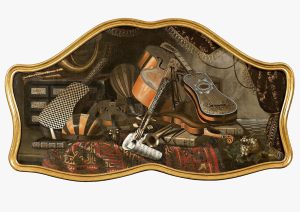Bartolomeo Bettera (Bartolomeo Bettera, 1639 – after 1699) and his son and student Bonaventure Bettera (Bonaventura Bettera, 1663-1718) specialized in still lifes with musical instruments, continuing the tradition of the Bergamese Evaristo Baschenis (Evaristo Baschenis, 1607-1677), who introduced this genre to Bergamo in the 17th century. Proximity to Bergamo Cremona, an important craft center for the manufacture of stringed instruments, naturally disposed the Bergamo artists to specialize in still lifes on a musical theme. The work of Bettera in Bergamo and the more eccentric Arcimboldo in Milan represents the first appearance of the still life genre in provincial Italian centers. It quickly adopted local features, including the painters’ emphasis on form and texture, and was called “silent geometry”.
The artist’s works are presented in museum and private collections, including the Saint Louis Art Museum, the Museum of Fine Arts San Francisco, at the Museum of Art History in Vienna, at the Museum of Fine Arts Houston (Texas), at the National Gallery of Ljubljana (Slovenia), at the Ringling Museum of Art in Florida, at the Israel Museum (Jerusalem), etc.
“Still life with musical instruments”
The image of musical attributes and scenes of music-making occupies a significant place in the painting of the 17th century. Many portrait, still life and genre compositions include lutes, violins, flutes, virginals and other Renaissance and Baroque instruments. The artists represented in the paintings string duets and family concerts, cheerful companies with melodic accompaniment, solo musicians. The popularity of this theme reflected new achievements in the art of the 17th century, testified to the expansion of the subject horizons of artists.
In the Renaissance, when everyday painting, portrait and still life did not have an independent status, being components of the historical genre, musical instruments were included in biblical and mythological compositions. Only with the division of painting into these genres in the 17th century did the theme of music acquire independent significance, began to exist as one of their subject areas: in the portrait, it was transformed into “family concerts” and accompanied the self-portraits of artists surrounded by attributes of art, which included musical instruments; in the everyday genre, it had a more detailed division – into “concerts”, “duets”, “music lessons”. In the Leiden still life, the attributes of music were symbolically combined with books, hourglasses, maps, personifying “hearing”, “vanity of vanities” and the high status of art and science. The didactic moralism of the emblema influenced the semantic meaning of musical plots, which gave the paintings a moralizing coloring.
If in the Italian Renaissance they corresponded to the thesis “Love is always in the company of music”, formulated by D. Vasari to P. Veronese’s allegorical tondo “Music”, then in Dutch painting this theme was associated, on the one hand, with the idea of the transience of life and fun pastime, and on the other hand, it was identified with family and spiritual harmony, in which two instruments located side by side symbolized the consonance of two loving hearts . At the same time, the music hinted at the passing time without a trace, the moments of which were likened to the notes of a melody performed by musicians.


Private collection, Zurich
Art Rules, Tallinn, Estonia, 2015
Kunstberatung Zürich AG
Börsenstrasse 27 8001 Zürich Switzerland
VAT Number: CHE-113.608.140
+41 44 381 50 40
contact@kunstberatung-zurich.com
©2025 Kunstberatung Zürich AG No part of this website may be reproduced, distributed, stored in a retrieval system or transmitted in any form or by any means, electronic, mechanical, or otherwise, without the prior permission of Kunstberatung Zürich AG.